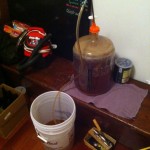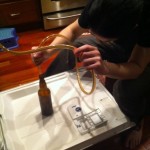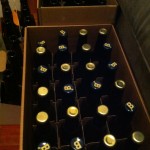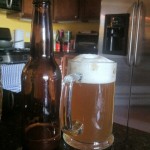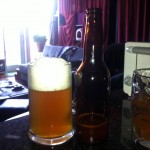Massive success! Despite periods of worry, hand-wringing, incessant laments, batch #1 has proven to taste like … beer! And a fine one, at that. Frankly, my lifelong habit for setting my expectations low might have had something to do with it, but I wholeheartedly endorse this manner.  For example, were I to have been in the habit of setting high expectations, I never would have enjoyed Last Action Hero.
For example, were I to have been in the habit of setting high expectations, I never would have enjoyed Last Action Hero.
Brewing commenced on May 12, 2012. As mentioned in my previous post, being a complete noob at the brewing thing, I copped out and and went the easy route with Brewer’s Best American Cream Ale ingredient kit. 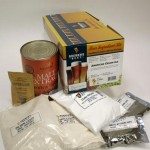 The kit includes some minimal instructions, which can also serve as something of a home brewer’s journal, on which I jotted down some notes to help me remember the experience.
The kit includes some minimal instructions, which can also serve as something of a home brewer’s journal, on which I jotted down some notes to help me remember the experience.
After reading through many opinionated essays on home brewing, it would seem that I found multiple the-most-important-thing-to-remember. One that particularly stands out in the dogma of sanitizing everything that comes into contact with the wort (unfermented beer stew). The handy little bottle of Star San that came with my brewing kit helped nicely. An ounce of that stuff in 5 gallons of tap water gave me plenty sanitizing agent to work with. The following day I wondered why the skin on my fingers was so flakey. A closer inspection of the bottle found me reading the words “acid sanitizer.” … Oh. Well, after a couple days, my hands were right as rain. Of course, all this talk about sanitation leaves me scratching my head when one dumps 2.5 gallons of cold, unboiled tap water into the boiled wort.
Opening each ingredient in the kit was quite the sensory experience. Each packet contained one of many subtle aromas and flavors that, as a whole, comprise a fine beer. My grin increasingly widened as the wort took shape (or maybe it was the effect 12-pack of 312 that I was concurrently enjoying).
Hydrating the dry yeast in hot water was a joy. Seeing those little critters bubble and multiply—ok, one would be hard pressed actually to see them multiply; you just have to take their word for it that that’s what they’re doing in that frothy mess—anyway, it made me feel like Dr. Frankenstein. They’re alive!
Eventually I’ll start to care about the specific gravity, but at this point, I simply went through the motions more so out of curiosity to know what the final alcohol level would be. For the record, the original gravity measured 1.053.
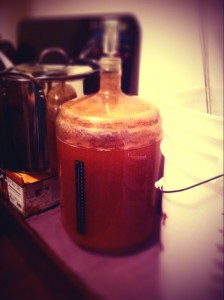 Once the carboy was filled and capped with the fermentation lock, all that was left to do for the time being was wait. After a couple days, there was some heavy action. I think the temperature in the guest room was a bit high, because the froth on top bubbled out of the fermentation lock a bit. Not too much of a mess, but enough to give me an initial panic that I did something horribly wrong.
Once the carboy was filled and capped with the fermentation lock, all that was left to do for the time being was wait. After a couple days, there was some heavy action. I think the temperature in the guest room was a bit high, because the froth on top bubbled out of the fermentation lock a bit. Not too much of a mess, but enough to give me an initial panic that I did something horribly wrong.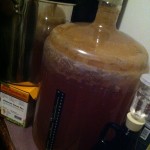
Eventually all noticeable fermentation had ceased. The fermentation lock stopped bubbling. The final gravity measured a stable 1.010 for a couple days. So, on Sunday, May 27, fifteen days after brewing, we bottled. I was pretty concerned that the beer tasted a bit off. Maybe a bit cidery or sour, which could indicate a contamination from improper sanitation, but we plowed forth.
Thankfully I didn’t forget to add the priming corn sugar to reactivate the dormant yeast (they eat the sugar and pass gas, which is the lovely carbonation that you so much enjoy). Boiled that up good and poured it in the bottling bucket. This got me thinking that people in ancient times must have had only flat beer, since it’s unlikely that they could or would bother to create an airtight vessel large enough and thick enough to hold beer as it was carbonating. I looked in to using a take-away glass growler jug for bottle conditioning, and all the sources I could find said “Don’t do it! The glass of a growler jug isn’t thick enough. It will explode.” If a glass jug would explode under that pressure, I suspect the types of ceramic vessels that the Ancient Egyptians and Mesopotamians used would also.
The siphon that came with the brewing kit made short work of transferring the brew into the bottling bucket and it was exciting to watch! Science! A nifty little trick I saw online at The Homebrew Academy demonstrated bottling over the open door of the dishwasher. Brilliant! Decent flat surface, elevated area for the bottling bucket, easy cleanup.
After 11 days of bottle conditioning, on June 7, 2012, the wife and I cracked open our first homebrew. Anticipation was high. There was a profound “Hhhsssss!” as the opener removed the cap. We have carbonation! The taste … not bad. Perhaps a subtle yeasty flavor, but that might just be the “cream” of the cream ale, which I confess I’m not all that familiar with.
And the next day, to document this new hobby and include my musings as I simultaneously explore brewing in the ancient world, I started this blog.
Cheers!

